
The Role of Cooperative Breeding in Modern Human Evolution
Journal of Human Evolution 63 (2012): 52-63 http://dx.doi.org/10.1016/j.jhevol.2012.03.009, Allomaternal care, life history and brain size evolution in mammals Isler, Karin, and Carel P. van Schaik. Humans stand out among the apes by having both an extremely large brain and a…
Identity Politics in the Name of Science: The Battle over American Indian Blood and Bones Continues
As we learned in my previous post, Reich et al. (2012, 4) claim to have conducted the “most comprehensive survey of genetic diversity in Native Americans so far.” I noticed that their study admitted a few ironies and misapprehensions, but…
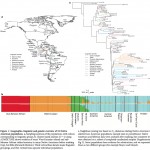
A Three-Wave Model for the Peopling of the Americas, or a Three-Wave Back-Migration from the Americas to the Old World
Nature (2012) doi:10.1038/nature11258 Reconstructing Native American population history Reich, David, et al. The peopling of the Americas has been the subject of extensive genetic, archaeological and linguistic research; however, central questions remain unresolved. One contentious issue is whether the settlement occurred…
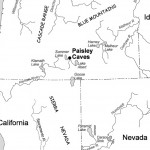
The Western Stemmed Tradition, Clovis and mtDNA 9-bp Deletion
Science 13 July 2012: Vol. 337 no. 6091 pp. 223-228 DOI: 10.1126/science.1218443 Clovis Age Western Stemmed Projectile Points and Human Coprolites at the Paisley Caves Jenkins, Dennis L. et al. The Paisley Caves in Oregon record the oldest directly dated human…
Out-of-Africa in the Mid-Pleistocene: A New Interdisciplinary Paradigm or a New Myth?
In the comments section on this blog, Dienekes raises the issue of interdisciplinary support for the out-of-America theory. Since I’m a big proponent of interdisciplinarity, the seeming convergence of genetics, archeology and paleobiology on the origin of modern humans in…
The Pontic Steppe vs. the Bactrian Homeland of the Indo-Europeans
Dienekes, the confused blogger from my previous post, continues to be confused and confusing. In the comments section of Razib’s Discover Blog, he concedes: “As of late, I am rather more willing to give even Johanna Nichols’ 1997 model of…
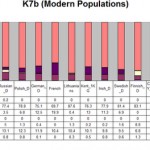
A Near Eastern Origin of the Indo-Europeans – An Internet Hoax? Observations on the Writings of a Confused Genome Blogger
Dienekes has been campaigning for a while for the Indo-European homeland in “West Asia” or the “Near East.” I usually don’t actively discuss the origin of Indo-Europeans and technically this question falls outside of the theme for this blog. But…

Neandertal Admixture in microRNA Genes
Molecular Biology and Evolution (27 January 2012), doi:10.1093/molbev. An Ancestral miR-1304 Allele Present in Neanderthals Regulates Genes Involved in Enamel Formation and Could Explain Dental Differences with Modern Humans Lopez-Valenzuela, Maria, Oscar Ramirez, Antonio Rosas, Samuel Garcıa-Vargas, Marco de la…

Howler Monkeys, Neandertals, Pygmies, Khoisans and More: Society for Molecular Biology and Evolution 2012
As I write, Society for Molecular Biology and Evolution (SMBE) is conducting its annual meetings in Dublin, Ireland. Dienekes has many useful pullouts from the available abstracts. I will make short comments on a few of them, plus bring in…
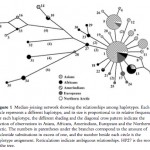
Molecular Variability of the 16p13.3 Region in American Indians
Annals of Human Genetics (2007) 71, 64–76 DOI: 10.1111/j.1469-1809.2006.00296.x Molecular Variability of the 16p13.3 Region in Amerindians and Its Anthropological Significance Battilana, J., L. Cardoso-Silva, R. Barrantes, K. Hill, A. M. Hurtado, F. M. Salzano and S. L. Bonatto A…
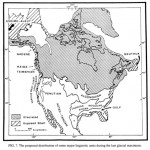
The Stereotype of a Beringian Refugium
The new paper “Mitochondrial DNA Signals of Late Glacial Recolonization of Europe from Near Eastern Refugia” by Maria Pala et al. (2012) seemingly has nothing to do with the “peopling of the Americas.” It argues, on the basis of a…
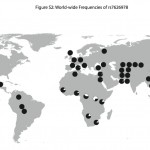
The Pygmy Enigma: Biology, Population Genetics and Linguistics
PLoS Genetics 8 (4): e1002641. doi:10.1371/journal.pgen.1002641 Patterns of Ancestry, Signatures of Natural Selection, and Genetic Association with Stature in Western African Pygmies Jarvis, Joseph P., Laura B. Scheinfeldt, Sameer Soi, Charla Lambert, Larsson Omberg, Bart Ferwerda, Alain Froment, Jean-Marie Bodo,…
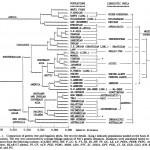
Phonemic Diversity and out-of-Africa Again: The Myth is Gaining a Momentum
PLoS ONE 7(4): e35289. doi:10.1371/journal.pone.0035289 Dating the Origin of Language Using Phonemic Diversity Perreault, Charles, and Sarah Mathew. Abstract Language is a key adaptation of our species, yet we do not know when it evolved. Here, we use data on…

More on Amerindian mtDNA haplogroups X2, B2 and C4: Evidence from Siberian Tubalars, Tuvans, Evens and Ulchi
American Journal of Physical Anthropology Vol 148, No. 1, pages 123-138, May 2012 DOI: 10.1002/ajpa.22050 Mitochondrial Genome Diversity in the Tubalar, Even and Ulchi: Contribution to Prehistory of Native Siberians and Their Affinities to Native Americans Sukernik, Rem I., Natalia V….

Between Behar et al. 2012 and Johnson et al. 1983: The Mitochondrial DNA Tree Comes of Age but Remains a Blunt Tool for Human Evolutionary History
American Journal of Human Genetics, Volume 90, Issue 4, 675-684, 6 April 2012 doi:10.1016/j.ajhg.2012.03.002 A “Copernican” Reassessment of the Human Mitochondrial DNA Tree from its Root Behar, Doron M., Mannis van Oven, Saharon Rosset, Mait Metspalu, Eva-Liis Loogvali, Nuno M….
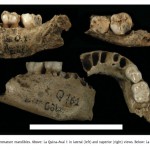
Early Aurignacian Dentition and Why Paleontology Is a Moving Target
Journal of Human Evolution (In Press, Corrected Proof) The Early Aurignacian human remains from La Quina-Aval (France) Christine Verna, Véronique Dujardin, and Erik Trinkaus. There is a dearth of diagnostic human remains securely associated with the Early Aurignacian of western…
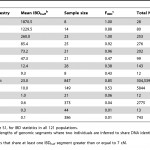
The Effect of Long-Term Endogamy on Identity-By-Descent
PLoS ONE 7(4): e34267. doi:10.1371/journal.pone.0034267 Cryptic Distant Relatives Are Common in Both Isolated and Cosmopolitan Genetic Samples Henn, Brenna M., Lawrence Hon, J. Michael Macpherson, Nick Eriksson, Serge Saxonov, Itsik Pe’er, Joanna L. Mountain. Although a few hundred single nucleotide…
Piraha Indians, Recursion, Phonemic Inventory Size and the Evolutionary Significance of Simplicity
Daniel Everett has a new book out that will surely stir more controversy around Piraha Indians, Chomskyan recursion and the evolution of human language. I haven’t read this book yet, but The Chronicle of Higher Education has an extensive coverage…
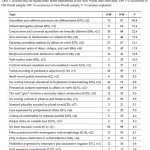
American Indian Uniqueness: Linguistics and Genetics
Journal of Linguistic Relationship 5 (2011): 130-134. Similarities among Languages of the Americas: An Exploration of the WALS Evidence Wichmann, Søren, Eric W. Holman, Dietrich Stauffer, and Cecil H. Brown. Abstract. An exploration of WALS (i.e. the World Atlas of…
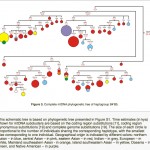
The Origin of mtDNA haplogroup B: 9-bp deletion in America, Asia and Africa
PLoS ONE 7(2) 2012: e32179. doi:10.1371/journal.pone.0032179 Complete Mitochondrial DNA Analysis of Eastern Eurasian Haplogroups Rarely Found in Populations of Northern Asia and Eastern Europe Derenko M., Malyarchuk B., Denisova G., Perkova M., Rogalla U., et al. Abstract. With the aim…
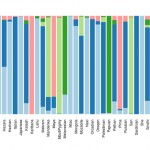
American Indians, Neanderthals and Denisovans: PCA and ADMIXTURE
Dienekes continued his search for “archaic admixture” in world populations. This time he blended ADMIXTURE and PCA approaches to plot 5 composite populations detected by ADMIXTURE in the Harvard HGDP set. American Indians are back in. The ADMIXTURE plot replicates…
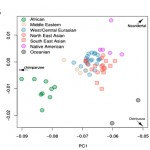
American Indians, Neanderthals and Denisovans: Insights from PCA Views
Dienekes posted a SNP PCA showing the relative position of a sample of modern human populations from the Harvard HGDP along the axes formed by Chimpanzees, Denisovans and Neanderthals. On the broad-view PCA, the red dot indicates Chimpanzees, the green…

American Indian HLA Genes on Easter Island
Phil. Trans. R. Soc. B 19 March 2012 vol. 367 no. 1590 812-819 doi: 10.1098/rstb.2011.0319 The Polynesian Gene Pool: An Early Contribution by Amerindians to Easter Island Erik Thorsby Abstract. It is now generally accepted that Polynesia was first settled by…
Archaic Morphology and American Indian Biological Variability
On the heels of my last post about the possibly systematic trend to ignore American Indian samples in the studies of worldwide variation, there’s a new paper dealing with the discovery of human remains with archaic morphology as late as…
Are American Indian Populations Subject to Sampling Bias in Human Origins Research?
The latest post by Dienekes re-kindled an observation that I wanted to make for a long time. Dienekes applied TreeMix software to ADMIXTURE components derived from HapMap-3 populations and created a tree with Sub-Saharan, East African, Northwest African, Gedrosia, Southwest…
Admixture: An Amerindian Component in Eurasian Populations
About a year ago, one of genome bloggers, Diogenes, discovered, using ADMIXTURE, an intriguing “Amerindian” component in a wide range of East and West Eurasian populations. Here are the results of his ADMIXTURE runs. Grey represents the component that’s modal…
Solutrean and Clovis
John Hawks complains about the hype around the book by Dennis Stanford and Bruce Bradley’s long-awaited book Across Atlantic Ice: The Origin of America’s Clovis Culture. Posing as an honest academic only interested in facts and not hype, Hawks writes…
Neanderthals and Amerindians: Intragroup Genetic Diversity and Population Size
John Hawks writes: “Neandertals have strikingly limited genetic variation. They once lived across a range from Spain to Siberia. Yet when we compare sequences across their whole genomes, we find them to be much less different across this geographic range…
Welcome to Anthropogenesis!
Welcome to Anthropogenesis, the only scientific weblog that addresses human origins from a holistic, anthropological perspective.


Recent Comments